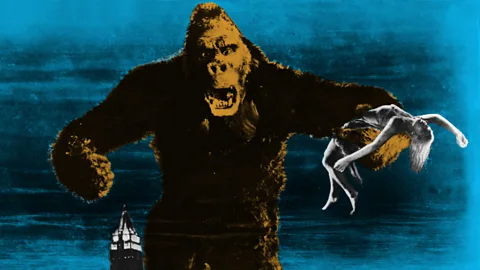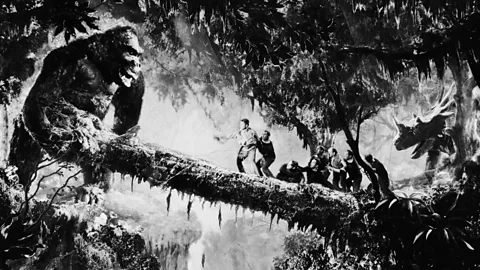King Kong at 90: The greatest monster film ever made
 Getty Images
Getty ImagesNinety years on from its premiere in New York, King Kong remains one of the most terrifying and heartbreaking horror movies ever made, writes Nicholas Barber.
Despite having been released 90 years ago, in 1933, King Kong still stands tall as the greatest monster movie of all time. In part, that's because Kong himself was made for the movies. Unlike Dracula, Frankenstein's creature and other such fiends, he didn't emerge from a novel or a folk tale. The idea of an overgrown, awe-inspiring ape was conceived as a purely cinematic spectacle by Merian C Cooper, who co-directed the film with his friend Ernest B Schoedsack. The men were already well known for their silent documentaries, Grass (1925), and Chang (1927), featuring exotic animals in far-off lands, but Cooper fancied making a fictional "terror gorilla picture". All he needed was "a chariot race", he recalled (as quoted in Celluloid Skyline by James Sanders), meaning a climactic sequence to compare with the frenetic chariot race in 1925's Ben-Hur: A Tale of the Christ. One day in New York, he saw a plane flying past a skyscraper, and realised that he could add his gorilla to the tableau. "And I saying aloud to myself, 'Well, if that isn't a chariot race, I don't know what is.'"
Sure enough, the tragic set piece in which Kong clambers up the Empire State Building with Ann Darrow (Fay Wray) in his hand, before being strafed by biplanes and plummeting to the pavement, is one of the most famous, most heart-rending, and most parodied sequences in cinema history. It's a sequence that couldn't work on stage, in prose, on the radio, or anywhere else except in a big-screen blockbuster.
 Getty Images
Getty ImagesNor would it work without the film's iconic title character, who prompts a unique balance of fear and sympathy. From the moment he crashes into view in a primeval jungle, Kong is more obviously frightening than any other movie monster: with a height that varies between 18ft and 60ft, as the scene demands, he can squash the competition flat with one titanic foot stomp. But no other movie monster gets the viewer on his side so quickly. Within minutes, he is fighting for survival with a Tyrannosaurus rex and a Pteranodon, and he has the most understandable human motive for his behaviour: he's got the hots for Fay Wray. More importantly, the film's chief model-maker, animator and special effects specialist, Willis H O'Brien, invests him with far more personality and soul than Godzilla would ever have. Ticking off every trick in the pre-CGI book, O'Brien often puts real actors, matte paintings, miniatures, and stop-motion animation in the same frame with an ingenuity that still seems like wizardry.
King Kong isn't just a great monster movie, though. It's also one of Hollywood’s best films about Hollywood. In the last year, Jordan Peele's Nope used monster-movie tropes to comment on the film industry, and Damien Chazelle's Babylon revelled in the insanity of Tinseltown in the 1920s. Yet King Kong got there first, commenting on itself with a wit that seems positively postmodern, and condemning monomaniacal directors decades before their peers began to frown upon them.
Just to make Cooper's preoccupations clear, the very first line of dialogue is, "Say, is this the moving-picture ship">window._taboola = window._taboola || []; _taboola.push({ mode: 'alternating-thumbnails-a', container: 'taboola-below-article', placement: 'Below Article', target_type: 'mix' });
